The 11 Best Fly Floatants: Tested and Ranked
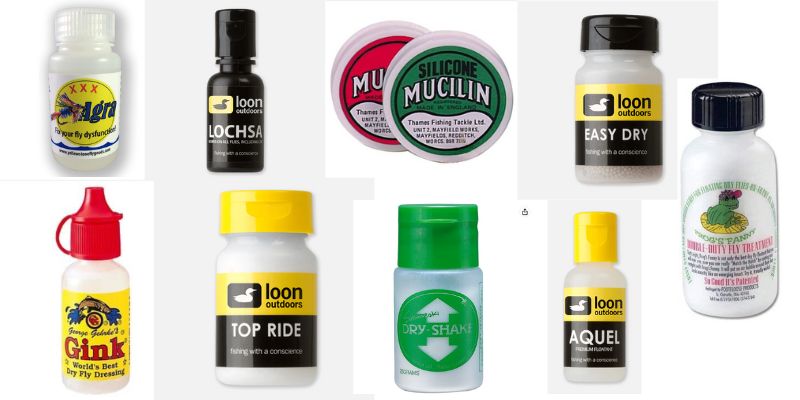
After testing out just about every good dry fly floatants and still using a few of them for many years, I’ll show you the best fly floatants that I use, and I will provide some tips that I use to keep my dry flies dry for even longer.
Tests that I have done, and some from others, show that most dry fly floatants will keep a fly from absorbing water and sinking for 3 to 8 minutes, while some of the best dry floatants can keep your dry fly high and dry and floating for over 15 minutes.
One thing I can tell you is that in my experience, almost always, flies riding high on the surface tend to catch a lot more fish.
The fly floatants for dry flies are:
- Umpqua Shimazaki Dry-Shake Powder – Best Shake Powder
- Loon Outdoors Aqual Gel floatant. – Best Gel Floatant
- Loon Lochsa – Best For CDC Flies
We may make a small commission from some of the links on this website, which is at no cost to you. I appreciate your support. Learn More
What Is Fly Floatant?
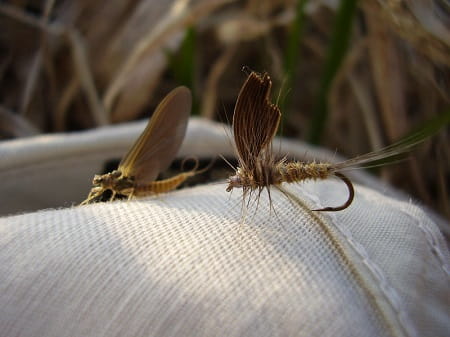
A fly fishing floatant is a liquid, gel, cream, or paste-like substance of water-resistant material to keep your flies afloat when river fishing or lake fishing with flies that float on the surface.
Dry fly floatants provide a water-deterrent or water-resistant coating to keep dry flies floating longer and higher on the surface of the water.
Without applying dry fly floatants effectively, your flies will absorb water quickly and then sink.
The Top Fly Floatants And Desiccants Are:
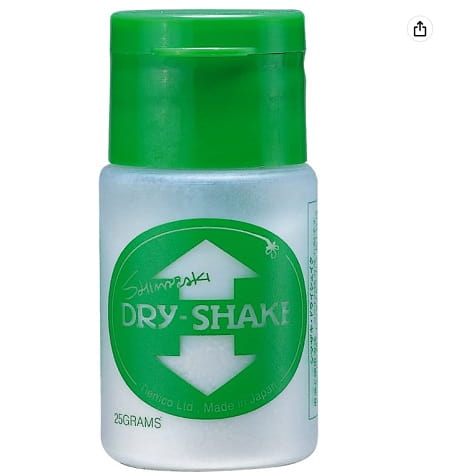
After testing and using fly floatants in real fishing situations, there are 3 out of 11 that I recommend because these are the ones that keep my flies floating high and for long.
I will also reveal my process for using these to maximize them.
There is one other that is probably better at floating your fly longer than all of these floatants but it is not an environmentally safe product and for that reason only it’s not in my top three, however, it is listed below.
The Best Fly Floatants Ranked
Gel floatants are the ultimate choice for a dry fly floatant. I prefer a gel floatant because they are the best fly fishing floatants. My overall floatant rankings are based on both my professional and personal fishing experience.
1. Best Overall: Umpqua Shimazaki Dry-Shake Powder

Dry-Shake Powder by Shimazaki is an excellent absorbing powder for a dry fly floatant and reconditioning your flies.
Not to mention, powder dry shakes are easy to use and this one is as best as you will get in a pure powder floatant.
Once your fly no longer floats on the surface, simply drop the fly in the dry shake container and shake it up!
The powder will remove the moisture from the fly and it will coat it with a water-resistant material.
My tests show this powdered dry fly dressing float flies 3 to 4 times longer. While most floatant will keep you fly up and floating for 5 to 10 casts, the Umpqua Dry-Shake will give me 20 to 40 casts.
Other tests I have seen show flies will float for 18 minutes compared to 6 to 8 minutes of other flaotants.
Pro-Tip #4. With the fine powder desiccant shakes, they will hold that powder blow it off before you apply any gel, and be careful not to breathe in.
2. Best Gel Floatant: Loon Aquel Gel
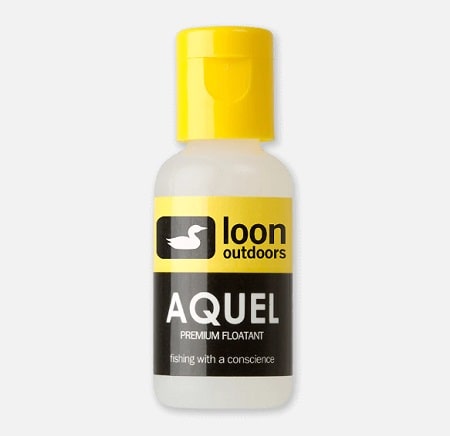
Loon Aquel is my favorite dry fly floatant gel and there are a couple of things I like which include its price and the fact that based on tests it seems to be better than most gels.
In combination with Loon Top Ride, it keeps my flies floating higher longer.
A popular and cost-effective floatant is made by Loon and based on multiple tests it seems to float flies longer than other gel-type floatants.
Generally, Loon Aquel Gel is priced at $5.50. A similar gel floatant to Gink, Aquel differs from other floatants because its viscosity doesn’t change with temperature.
A stand-out feature of Aquel is the claim that it has the ability to block human scent.
Pro-tip #5: Be sure to always dry your flies before you reapply.
3. Best For CDC: Loon Lochsa
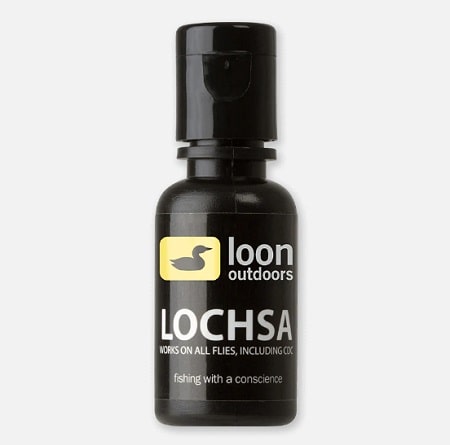
Loon’s Lochsa is my favorite gel floatant for flies with CDC feathers however this fly floatant gel works on all flies.
Like all Loon products, it’s environmentally friendly.
In my professional opinion, this makes Loon Lochsa one of the very best floatant for CDC flies.
A very similar gel, Loon’s Royal Gel is another effective product on the market that gives the fly some glitter, however, I’m not entirely sold on this unless I’m using attractor patterns like a Royal Coachman.
Pro-tip #6: Apply a desiccant before you reapply Lochsa or Royal Gel.
4. Longest Lasting: Fly-Agra Liquid
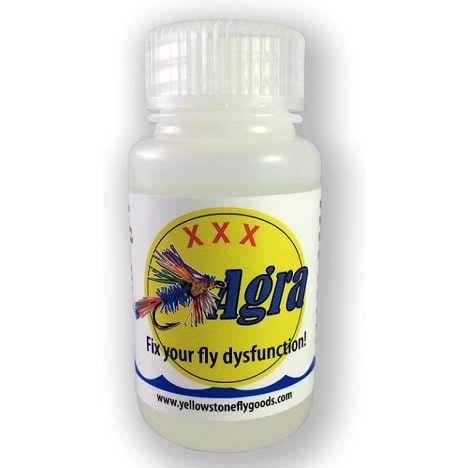
Best Non-Environmentally Friendly Floatant
Fly-Agra (funny name) is becoming the most popular brand of liquid floatant simply becuase it keeps flies from becoming waterlogged longer than any other fly floatant i have tested.
That means your flies float longer than all other fly floatants. Yes Fly Agra is the best of the best.
However, unfortunately, Fly-Agra apparently is not environmentally friendly, so I’m told.
However, one application of Fly-Agra keeps dry flies floating for like what seems forever and it’s so minuscule that I doubt it affects the environment much.
Pro-Tip #7 Too much gel or paste floatant will sink your fly. Rub it is and dab dry with your shirt sleeve so the fibers are coated but not soaked.
5. Best Paste Floatant: Mucilin Silicon Paste: Red Can
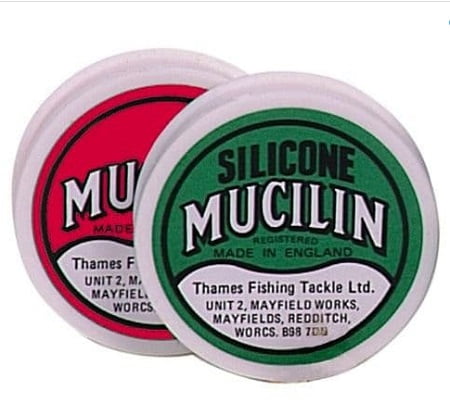
I don’t know if you have noticed but the top four floatants above were all the best for different reasons.
Mucilin Silicon Paste in the red can is a classic choice according to most fishermen and it is also somewhat unique.
This is a silicon paste that has been proven over decades of use.
I have been using the red can and green can for probably over 30 years. The green can is non-silicon based.
Mucilin’s red and green can alter consistency in cold weather by becoming hard and soft in warmer seasons. Both work well for artificial flies.
The best thing with Mucilin is it is also great for lubing and floating your leader, and your fly line. I use it more for that than I do for my flies.
The downside, and don’t let this deter you, is this stuff can turn to liquid in the summer and leak all over your vest or pack, and in the winter, when below dressing it’s as hard as a rock.
I keep my Muciln in a zip lock bag during the summer just in case it liquefies.
6. Frog’s Fanny Powder:
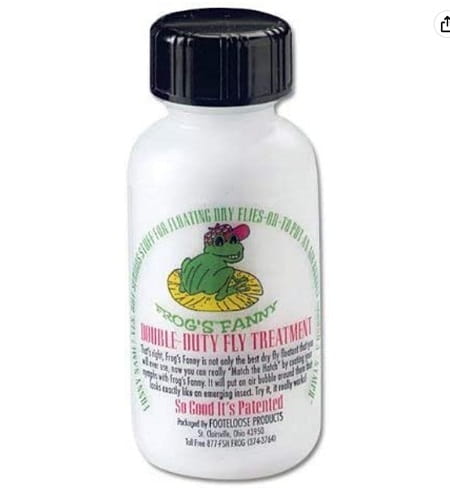
Frog’s Fanny dry fly floatant is great for all dry flies including CDC flies. It is a powder-based product and my tests indicate it’s one of the top 3 longest-lasting fly floatants.
I have a love-hate relationship with Frog’s Fanny. On one hand, it floats flies longer than almost all other floatants. On the other hand, you need to brush on the floatant which is a pain in the butt, and you end up wasting it and wasting time.
Some anglers like the brush so you can tease the powder into wings and fur, but I hate wasting time.
For this reason, I no longer use Frog’s Fanny, however, some guys love it.
One upside is that anglers are using it on nymphs because Frog’s Fanny Powder traps air bubbles on the nymphs, which looks like an emerging insect to a fish.
7. Loon Top Ride Powder Desiccant
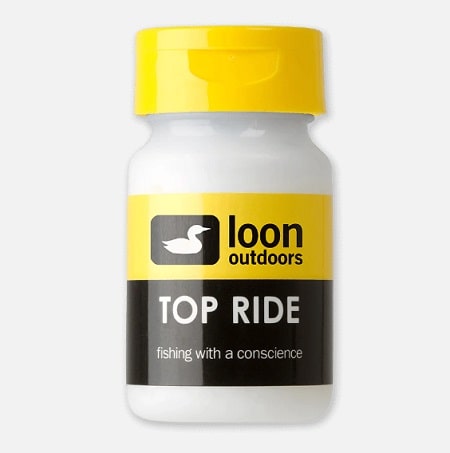
I have used this for many years, and based on my personal fishing experience, my time on the water has proven that Top Ride by Loon Outdoors is a great desiccant powder dry shakes.
Both a desiccant and powder floatant that also works well for CDC flies and small flies.
I use Loon’s Top Ride Desiccant because it’s easy to use, just put your fly in the bottle gently close the lid and shake for 5 seconds. I blow off the excess powder, (don’t breathe it in) and then apply a floatant like Loon Aqual.
I also tested Loon Outdoors’ Blue Ribbon, a popular pure powder floatant. Loon offers a combo pack with Blue Ribbon floatant and a desiccant.
8. Best Stand Alone Desiccant: Loon Easy Dry Desiccant
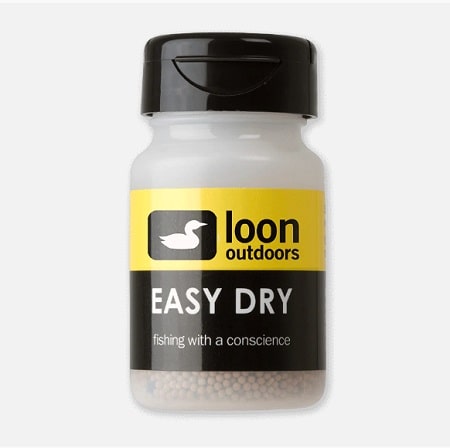
Loon’s Easy Dry is solely a desiccant and not a floatant. Easy Dry is little beads that such the water from your flies.
Unlike other desiccants, Loon Easy Dry doesn’t leave powder on your flies. I will use this desiccant before applying a floatant.
I have noticed that Easy Dry doesn’t dry small CDC flies effectively or large flies made of synthetic materials, but works great with fur and feathers.
A cool feature is that the blue beads in the mixture turn pink to let you know it time for a new bottle.
9. Gehrke’s Gink Gel
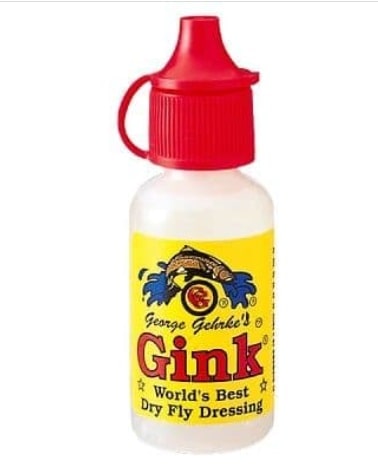
I think that Gink was the first safe dry fly floatant ever engineered, and it was the first fly floatant I’ve ever used.
In fact, I’m pretty sure I’ve used this floatant more than any other floatant simply because many years ago that was the only one I knew about.
Gink is still not CDC-approved but it is one of the cheap floatants and it works about as well as most gel type floatants.
Because Gink has been around for so long it remains a top choice for many anglers, however, the tests I’ve done show it is slightly less effective than Loon Aqual so I use Aqual now instead.
Gink is a popular floatant because it works on synthetic or hair material flies.
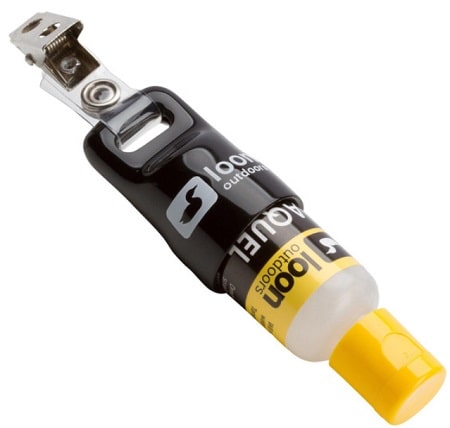
Loon Outdoors Bottoms Up Bottle Holder
This is a neat little floatant holder that attaches to your vest or jacket. I holds bottles the size of Aqual and Gink.
It makes for easy access so you’re not digging through pockets to find your floatant.
10. Dry Magic
The best thing about Dry Majic is the bottle. Otherwise, based on my testing and other people’s tests, it is about equal to many other dry fly gels.
The downside is that it’s expensive compared to other floatants.
The only reason I include this on my list is that it’s sold in local fly shops and anglers and my clients keep asking me if it’s good or not.
I do not use this because I prefer other floatants.
11. Umpqua Shimazaki Dry-Shake Liquid Spray
After countless hours on the water, I approve this Dry-Shake Liquid to keep your fly floating on the surface. It does leave a white residue behind and is on the more expensive side of floatants but still, a great liquid floatant that will keep your flies riding high. It is another floatant that makes reconditioning flies easy.
How To Decide On The Best Floatants
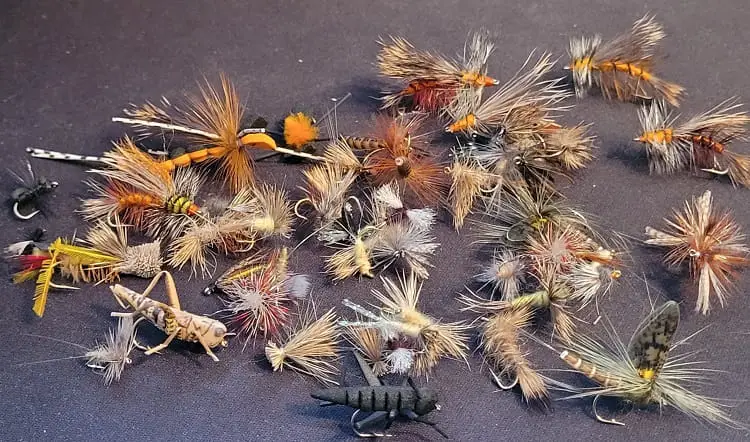
The overabundance of fly fishing floatants on the market causes a huge diluted pool of products to choose from, which can leave anglers uncertain, and to be honest, there are some that are much better than others.
Even though fly fishing flies are made of synthetic and organic materials — like hair, fur, and feathers — the fly floatants should be environmentally friendly and versatile. Floatants range from silicon gel-based to paste-based.
In my opinion, silicon gel-based and paste-based floatants are the superior choices over brush-on and spray-on fly floatants.
When Do You Use Fly Floatant?
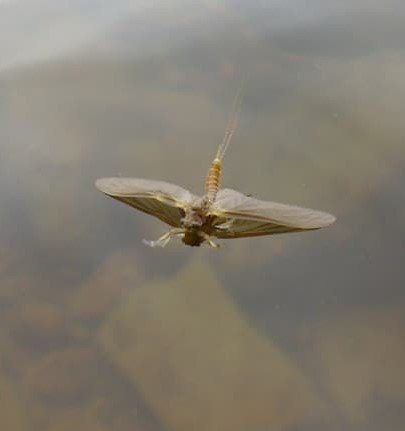
The simple answer is anytime I use a dry fly.
There are three times when I will apply my fly floatant.
- At the fly-tying table
- After I tie my fly onto my tippet
- Once the fly begins to sink and after the fly is waterlogged, AKA saturated and sinking
Pre-Treated Flies
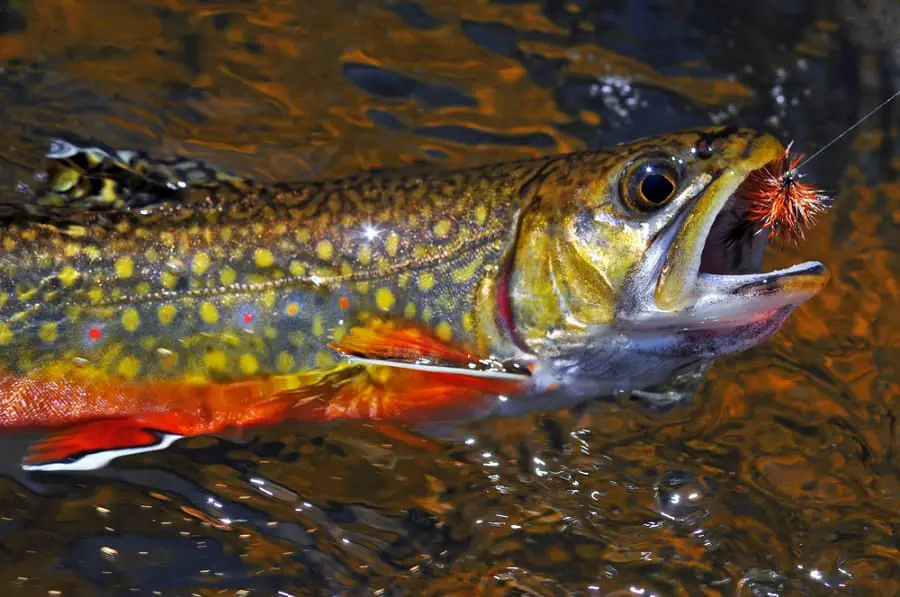
In my experience, pre-treating flies with a floatant at least an hour before fishing does help keep the fly floating longer.
I’ll even tie five to 10 dry flies, and once the head cement is dry, I’ll pre-soak them in a liquid called Water Shed fly floatant before I put the flies into my fly box.
Pre-treating gives the synthetic fly floatant substance time to soak into the fibers of flies and allows the fly floatant to completely dry, which makes the flies very water resistant.
With some of the gell type or paste floatants or sticky floatants, if you treat flies too early, they will collect dust and trap dirt. This is why I only use a liquid fly floatant that is good for pre-treating flies.
Pre-treating a fly about an hour before fishing with any floatant can also work equally well because you will be using the fly soon. I do this with every dry fly I use. For suggestions on the most effective Trout Flies click the link.
Apply After You Tie On Your Fly
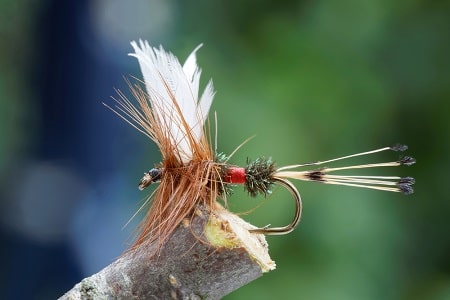
I always apply floatant to dry flies before I fish. I will add fly floatant like a paste to a fly, (even if it is a pre-treated fly) immediately after I tie on my fly.
If your dry fly gets wet before you apply floatant, I would recommend that you tie on another fly because a wet fly won’t absorb the floatant well or at all.
A fly that has already absorbed water won’t work well with the fly float water-resistant material.
Pro-tip #1: Never put fly floatant on flies tied with cul-de-canard or CDC flies with feathers, unless it is made for CDC.
Steps To Use Fly Floatant Once A Fly Is Wet?
I pre-treat my favorite dry flies, but over time, they will slowly absorb water and start to sink. They will quickly get waterlogged or slimmed after the fly has been in the mouth of a fish.
When this happens, I use these steps:
- If the fly has been slimmed by a fish, I will rinse the fly off
- I then blow the fly dry with my mouth to or three fast blasts of air
- I then squish the fly in an absorbent cloth or even in my shirt to absorb as much water as possible
- I put the fly into a desiccant and shake it up for 5 to 10 seconds
- I then reapply my preferred dry fly floatant
Done, that fly should continue to float for at least 10 to 20 casts, if not, I repeat that process.
If the fly refuses to float because it is far too water-logged, which happens, I tie on a new fly.
Pro-Tip #2: It’s a bit hard to explain, but I rarely use fly floatant once my fly is soaked. I find applying and re-applying a pain in the butt. Instead, I whip dry my fly as soon as it starts to take on too much water.
I’ve tried to teach this to new anglers and they always struggle, even experienced anglers struggle with this. However, it’s like snapping a whip or snapping a towel. If you can do it well, the snap almost completely expels all the water, or at least enough that the fly will float.
I may snap it two or three times about every 3rd or 4th cast. Sometimes I’ll do it every other cast.
This allows me to keep my fly floating while other anglers’ flies would be totally sunk.
Pro-tip #3: Apply fly fishing floatants before your sunscreen. The residue from sunscreen can transfer to a dry fly, which will deter fish. Even better is don’t use sunscreen at all, instead, use a good sunshirt that covers your hands or use sun gloves.
Use A Desiccant: Fly Floatant VS. Desiccant
An effective dry fly floatant agent provides a protective coat for water resistance. Whereas the desiccant absorbs water after the fly is wet, which maintains the buoyancy of a dry fly. Both floatants and desiccants are equally important.
Floatants are long-lasting, but eventually, water naturally seeps into a fly. While the desiccant (or dry shake) is a dry powder that removes water.
When a dry fly gets wet, it sinks below the surface of the water. This is when you reel it in and drop your fly into the desiccant. After I drop my fly in, I shake the desiccant bottle for 10 seconds or so, then I let it settle for an additional few seconds.
The desiccant is not as long-lasting as the floatant. A desiccant revives flies but only for approximately 5-10 casts before a reapplication is needed. More often than not, anglers will use desiccants more than floatants.
Conclusion
The best fly floatant is a combination of two things, a good fly floatant you apply before and after a fly gets wet, and a desiccant to remove the water before you reapply more floatant.
Tight Lines,
Graham

That was a nice review of current products out there and a tremendous help to new flyfishing enthusiasts. Thanks for sharing your experiences and knowledge base with us-even the one’s with tenure on the water.
Hey Ted,
I’m glad it helped.
Thanks
Great help. Thanks for writing this.